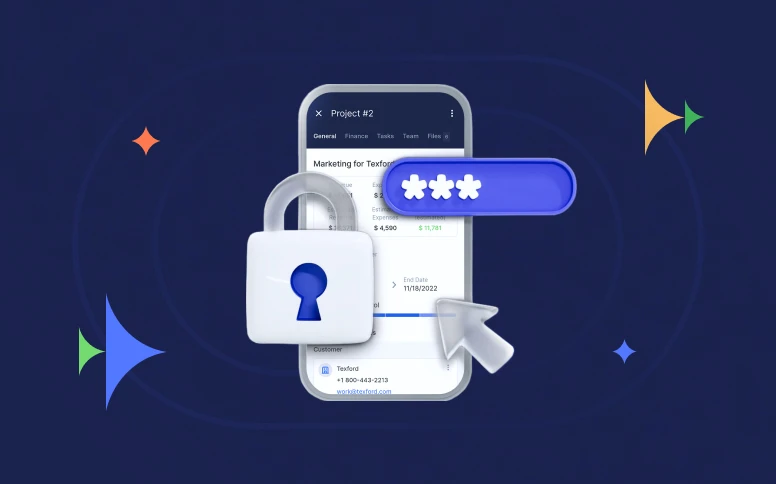6 Ways to Ensure Secure Project Management
Project security management is the process of identifying potential risks and putting policies into place to safeguard the privacy, integrity, and accessibility of project components. For project management security, information encryption is important, and data accessibility should be restricted. Your project's level of protection depends on the amount of security your project management software provides.
This refers to system reliability, infrastructure safety, and information accuracy and security. A lack of security can leave you at risk from hackers and other criminals. Excessive security, on the other hand, may prevent your employees from obtaining the data they require.
The safety measures should be adaptable and flexible while being strong enough to counter industry-known threats to your personal information. Thus, you can align them with your company's security policies, procedures, and guidelines.
Securing Your Project: Best Practices to Follow
The crucial security measures listed below can be implemented to ensure that information belonging to your company is protected on multiple levels. Putting these into practice may possibly make your project run better.
Create a Secure Password
Strong passwords play an important role in secure project management by adding a crucial layer of security against unauthorized access to confidential information about projects. Depending on your project, your data may be stored in different systems, such as cloud drives or accounts. Therefore Hackers or other online criminals can enter a system and steal data if their password has been hacked. With this knowledge, you must urge your team to adopt wise behaviors for establishing, saving, and exchanging passwords. About 10 to 12 words should be used in a password to make it challenging to guess.
In order to prevent hacking, the password should also contain a mixture of symbols, numbers, and uppercase and lowercase letters. To further strengthen security, enable authentication with two factors. With this configuration, users will have to go through an extra step to sign in to an account.
Consider Using a Password Manager
Having only one password to keep in mind for all of the accounts you have is easy. Unfortunately, that's not the most secure option. A smart practice is to use different passwords for your project's various accounts if you want to protect your data. For this purpose, it is undoubtedly beneficial to use a password manager.
An enterprise password manager can save complicated passwords so employees can retrieve them whenever needed, regardless of how complicated they are. Although setting them up can be confusing, once you get used to them, you'll realize they're useful. The password manager not only can store passwords but also works well at suggesting alternatives for any insecure password.
Security Awareness
Despite the existence of modern technological security measures, “people” are still seen as the least secure link in the cyber network. People are frequently convinced to provide their passwords for personal accounts by hackers. All organizations must, without any doubt, spend money on active “anti-phishing” advertising and education training emphasizing people. Additionally, identity theft protection should be a priority in safeguarding sensitive personal information.
The project management plan must include this approach’s implementation. The management of cyber security programs must be strategic and efficient to optimize return on investment, reduce possible risks, and safeguard firms, given the exponential growth of cybercrime and the significant investments made by businesses in security controls.
Standard Maintenance
For initiatives and projects to succeed, cyber security expertise is essential. Due to the high market demand for these abilities, lacking them could result in significant delays for ongoing projects. Organizations need a clear mechanism for employees to receive training or retrain in information security systems.
Project managers need a well-defined approach to improve staff abilities or reskill them in cyber security technology. Cybersecurity managers should also ensure that their teams regularly follow requirements, guidelines, and cases.
Develop a Central Storage
Finding the private and highly sensitive information required to be safeguarded is an effective place to start when safeguarding your data. Once you’ve found them, make an inventory for later review and tracking.
Keep your essential information in a centralized, highly encrypted location under constant surveillance of your cybersecurity experts. With central storage, one can control who has access to data and keep checks on any suspicious activity surrounding your repository.
Additionally, you may wish to consider a business management solution. This can be achieved through Flowlu, a one-stop business management solution that handles projects, CRM, invoicing, team collaboration, and knowledge management. You can increase your business's growth by organizing your entire workflow.
Use VPN
A VPN is an effective additional layer of security for companies employing an internet connection. In basic terms, a VPN directs your Internet Protocol (IP) address and data through a different secure connection between the Internet you’re using and the particular site you are entitled to view. From outsiders, it hides online activity.
Firms with hybrid or online infrastructures benefit the most from VPNs. Users can use affordable VPNs to protect sensitive information from hackers. Generally risky, public connections make it easy and simple for hackers to gather user information. So a VPN might help protect your personal information if you spend time in a coffee shop and join an unsecured internet connection.
Conclusion
Protecting data from unauthorized access, theft, and manipulation is the practice of data security. To achieve effective data protection, a project manager must responsibly and actively use data security strategies. This defense includes protections against viruses, malware, hackers' actions, insider dangers, and human errors. Security can be part of every aspect of a project, from formal connections with contractors and vendors to relevant policies, project management strategies, etc., to risk mitigation techniques. Some groups and organizations have gone even further, employing experienced management professionals with security knowledge to assist project managers and leaders.
To ensure the security of the project, you should follow the most important practices, such as information encryption, password management, data access restrictions, etc.
To manage the security of a project, you should first define requirements, then onboard the project’s team, identify possible vulnerabilities, and learn how to control and manage risks.
The overall success of a project depends on its security. Even a small data leak can lead to failure, especially if the information is leaked to competitors. Also, it helps to prevent additional costs, which you need to manage if it comes to dealing with the consequences of a lack of security.
Security in project management is the process of identifying, assessing, and mitigating risks to the project's security posture. It includes protecting the confidentiality, integrity, and availability of project data, as well as the security of the project's infrastructure and network.











